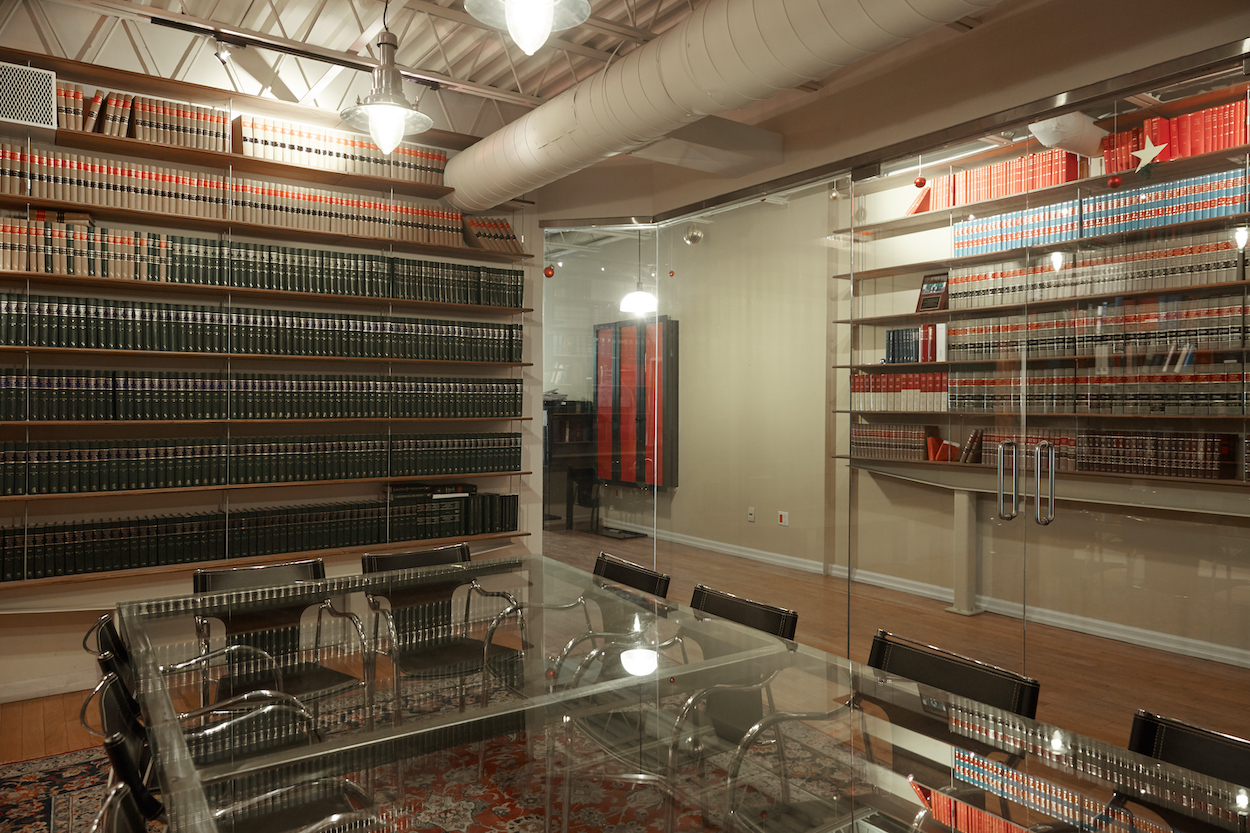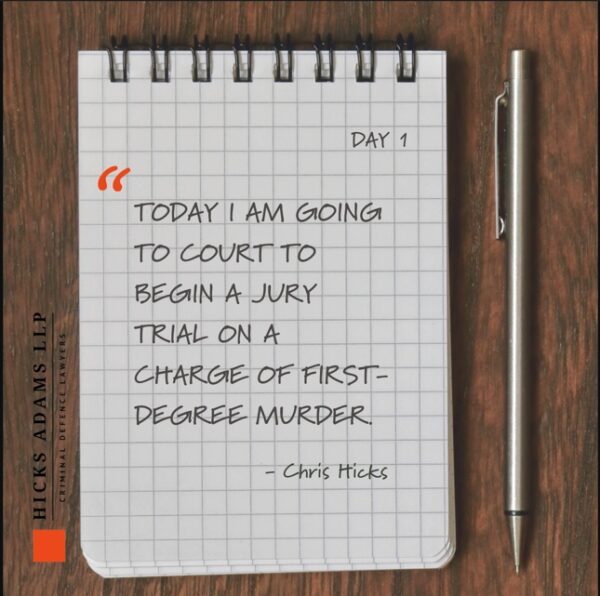Criminal defence lawyer and partner at Hicks Adams LLP Christopher Hicks has written a series of journal entries to take readers behind the scenes of something few people have exposure to: a trial for first-degree murder. In these journals, readers will experience the daily progress of a trial from the defence lawyer’s point of view, with the lawyer’s perspective on everything including witness testimony, judicial rulings and legal strategy.
Making this series especially unique is the fact that this is the first jury trial to go forward in Ontario after the start of the Covid-19 pandemic. With new safety protocols in place, everything is different from the placement of the jury, the lack of observers in the public gallery and even the freedom of movement for the lawyers.
In a nine-part series, Christopher Hicks will take readers through the highly unusual process of running a murder trial during a pandemic, providing rare insights and information as you follow along on the journey from start to finish.
DAY ONE
Today I am going to court to begin a jury trial on a charge of first-degree murder.
This is remarkable in and of itself, because of the Covid-19 virus. This will be the first jury trial in the province, if it goes ahead, to be held since March when the virus shut down so many aspects of our lives, both personal and professional.
As I always do, I take items that I need but which also give me comfort: a fountain pen inherited from my father, a Mont Blanc pen and a pocket watch, both gifts from my three boys, and court tabs from Quebec given to me by my wife.
And a mask.
This is going to be a lengthy trial of at least six weeks, and two panels of potential jurors have been summoned, with about 300 people in each group.
Two large panels have been assembled to keep people separated, and only about 150 people in the first group actually appear.
The trial judge, Justice Laura Bird, gives her opening greetings and instructions to the jurors, who are in a remote location. The only ones in the courtroom with the judge are myself and my colleague, Joanne Griffiths, the two prosecuting attorneys, Lisa Wannamaker and Andrew Midwood, and various court staff, including the registrar, Bernadette, and the court reporter.
We are all masked.
At various places where court staff, lawyers, witnesses and the judge sit, there are plexiglass shields for additional protection. The courtroom itself has been re-constructed. The traditional jury box, with jurors sitting shoulder-to-shoulder in two rows, is out of the question. Instead, the public gallery has been significantly reduced to accommodate chairs for the jurors, to allow them to maintain social distancing. You could throw a football in this courtroom.
This trial is a re-trial.
My client, Robert McGregor, was tried for first-degree murder in 2015 and convicted.
However, his appellate counsel, Richard Litkowski, conducted an appeal of that verdict in the Ontario Court of Appeal and, against the odds, won a new trial.
This is that second trial.
The first trial was in Peterborough, and the media coverage of that trial was outrageous and inflammatory. For this reason, an application was brought for a change of venue to move the second trial from Peterborough to another jurisdiction.
Justice Speyer heard the motion and accepted that the jury pool in Peterborough had been so poisoned by the publicity surrounding the first trial that a second trial would have to be held elsewhere. Oshawa would be the new venue for the next trial.
The Criminal Code of Canada allows an accused to question the partiality of the jurors before whom he or she will be tried. For this second trial of Robert McGregor, the obvious ground for challenging the partiality of prospective jurors was their exposure to the pre-trial publicity emanating from the first trial in Peterborough. Justice Bird allowed these questions to be put to potential jurors. Initially, potential jurors were dismissed or allowed to continue on the basis of their responses to questions probing their knowledge of that publicity in Peterborough.
There was another hurdle that potential jurors had to leap before becoming trial jurors: the peremptory challenge.
Both the prosecution and the defence have an equal number of peremptory challenges – twenty peremptory challenges each, in first-degree murder trials. These peremptory challenges can be used to dismiss a juror for no stated reason whatsoever, on an apparent whim or caprice.
There is always an unstated reason, however. Defence and prosecution counsel always have a fundamental idea of who should be on a jury, given the charge against the accused. Peremptory challenges assist both sides in establishing the basic composition of the jury.
Another unique feature of this trial – in addition to the change of venue and the publicity issue surrounding that first trial – is the fact that this is one of the last trials in Ontario to actually have featured peremptory challenges. The Supreme Court of Canada had decided that peremptory challenges are no longer necessary to ensure a fair trial.
This decision by the Supreme Court is not one I agree with, and neither do most trial lawyers. Peremptory challenges have existed ‘since time out of mind’, as lawyers in medieval times would say.
Without these challenges – and when challenges for cause are not relevant and appropriate – juries will be selected on a first-in-line, luck-of-the-draw basis, which I apprehend will have a serious impact on trial fairness. This is a decision made by people who don’t do jury trials. It is also a decision that is to the detriment of defence lawyers, who customarily use peremptory challenges much more than the prosecution does in an effort to achieve an impartial jury for their clients.
The judge and counsel have agreed that because of the anticipated length of this trial, as well as the menace of the Covid-19 virus, 14 jurors will be chosen rather than the traditional 12 jurors. A jury trial can continue with as few as 10 jurors, but no fewer, so a larger margin of error is necessary in these circumstances. With 14 jurors to be chosen, defence and prosecution are by agreement allotted 22 challenges apiece.
The challenge-for-cause questioning of potential jurors concerning their knowledge of the first trial elicits few positive responses. This matter is now almost 10 years old, and memories of the first trial and its inflammatory coverage have apparently faded – or never made it down the highway from Peterborough to Oshawa.
Stay tuned for future installments in this series, which will be posted every Monday.
Christopher Hicks is one of the founding partners of the criminal law firm of Hicks Adams. He has been practicing criminal law for more than 2 and a half decades, with a special interest, and extensive experience, in jury trials and appeals. In the course of his career, Christopher has been involved in scores of jury trials involving the most serious crimes in the criminal code, has argued appeals of both conviction and sentence in the court of appeal on a regular basis, and has represented clients in the Supreme Court of Canada on more than a half dozen occasions.
To reach Christopher or any of the experienced and dedicated criminal lawyers at Hicks Adams, contact the firm at 416-975-1700 or online to discuss your matter in confidence.



